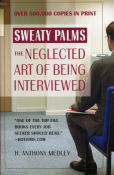| What REALLY goes on in a job interview? Find out in the new revision of "Sweaty Palms: The Neglected Art of Being Interviewed" (Warner Books) by Tony Medley, updated for the world of the Internet . Over 500,000 copies in print and the only book on the job interview written by an experienced interviewer, one who has conducted thousands of interviews. This is the truth, not the ivory tower speculations of those who write but have no actual experience. "One of the top five books every job seeker should read," says Hotjobs.com. | |
|
Ballets Russes (8/10) by Tony Medley Although my niece was a teenaged ballerina, I’m not a fan. So I went to this screening with trepidation, especially when I knew it would last almost two hours. To my surprise, the two hours flew by. This is not a performance; it’s a history of two ballet companies that dominated the world of ballet during the middle of the 20th Century. Serge Diaghilev was the impresario who ran the Ballet Russe in the early 20th Century, collaborating with artists like Nijinsky, Balanchine, Picasso, Miró, Matisse, and Stravinsky. When he suddenly died, in poverty, in 1929 his dancers and choreographers scattered. Three years later, however, the Ballet Russe was reincarnated into what eventually became two companies, the Ballet Russe de Monte Carlo and the Original Ballet Russe. Since this is the story of those two companies, the title is plural. The reincarnation was made possible by the three “Baby Ballerinas,” Atiana Riabouchinska, who was discovered by George Balanchine in 1931 when she was 14, Irina Baronova, and Tamara Toumanova. Baronova was only 12 years old when she joined the Ballet Russe de Monte Carlo in 1932. Toumanova was 13 years old when she joined in 1932. Riabouchinska and Baronova, who is still alive, are among the many ballerinas interviewed in the film. The film traces the progression of the two companies, how they immigrated to the United States just before World War II, and the new ballerinas, danseurs, and choreographers who joined the companies, and traces their eventual demise. The story is told with interviews with most of the principals, most of whom either are still living or only recently deceased, but most of whom had long lives. The main criticism I have of the film is that while a graphic is inserted with the names of the people who are dancing when showing old clips, there is no graphic identifying people being interviewed after the first appearance. The result is that the audience doesn’t really know which one of the ballerinas or danseurs it’s watching. It would be so helpful if there were a graphic showing the name of the person speaking each time they speak. It is extremely difficult to remember each person, especially as so many different people speak throughout the film… and I was taking notes! For people who don’t take notes, it would be even more difficult to identify these different people with unfamiliar Russian names who pop up throughout the film. The only person whose face I could identify with a name was Frederic Franklin, who was premier danseur for the Ballet Russe de Monte Carlo from 1938 on, where he established what became a legendary 20 year partnership with Alexandra Danilova in Leonide Massine’s “Gaite Parisienne.” Amazingly, at 91 years old, he still appears in “La Sylphide,” “Swan Lake,” and “Romeo and Juliet.” As for the others, I could never determine whether I was watching and listening to Riabouchinska or Baronova or Natalie Krassovska or Nini Theilade or Tatiana Stepanova. I did manage to get Maria Tallchief and Raven Wilkinson identified by sight. While there is not an abundance of dancing in the film, the clips are interesting. For a ballet aficionado, they must be fascinating, watching legends in action. There were enough for me. For someone into ballet there probably could have been more. If you don’t like ballet, don’t be put off by this under the misapprehension that you’re going to see lots of pirouettes and guys in tight leotards. This is basically a history of ballet, circa 1932-1962, told by the people who made the history! What’s inspirational about this film is the enthusiasm that the subjects still have for ballet and what they did. Many are still active as teachers. But they are all articulate and enthusiastic, with a joie de vivre that is infectious. I would have thought that sitting there for two hours listening to people talk about ballet, of all things, would quickly put me to sleep. But I was fascinated and walked out of the screening invigorated. November 2, 2005 |
|
|
|
|
